Related Research Articles
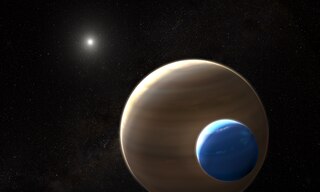
An exomoon or extrasolar moon is a natural satellite that orbits an exoplanet or other non-stellar extrasolar body.

A Super-Earth is a type of exoplanet with a mass higher than Earth's, but substantially below those of the Solar System's ice giants, Uranus and Neptune, which are 14.5 and 17 times Earth's, respectively. The term "super-Earth" refers only to the mass of the planet, and so does not imply anything about the surface conditions or habitability. The alternative term "gas dwarfs" may be more accurate for those at the higher end of the mass scale, although "mini-Neptunes" is a more common term.

A circumbinary planet is a planet that orbits two stars instead of one. The two stars orbit each other in a binary system, while the planet typically orbits farther from the center of the system than either of the two stars. In contrast, circumstellar planets in a binary system have stable orbits around one of the two stars, closer in than the orbital distance of the other star. Studies in 2013 showed that there is a strong hint that a circumbinary planet and its stars originate from a single disk.
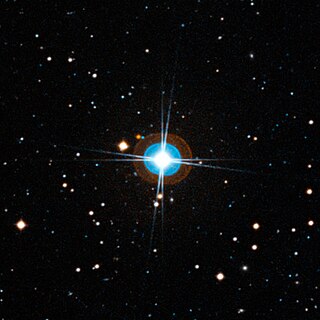
HD 10180, also designated 2MASS J01375356-6030414, is a Sun-like star in the southern constellation Hydrus that is notable for its large planetary system. Since its discovery, at least six exoplanets have been observed orbiting it, and some studies have proposed up to nine potential planets, which would make it potentially the largest of all known planetary systems, including the Solar System.

An exoplanet is a planet located outside the Solar System. The first evidence of an exoplanet was noted as early as 1917, but was not recognized as such until 2016; no planet discovery has yet come from that evidence. What turned out to be the first detection of an exoplanet was published among a list of possible candidates in 1988, though not confirmed until 2003. The first confirmed detection came in 1992, with the discovery of terrestrial-mass planets orbiting the pulsar PSR B1257+12. The first confirmation of an exoplanet orbiting a main-sequence star was made in 1995, when a giant planet was found in a four-day orbit around the nearby star 51 Pegasi. Some exoplanets have been imaged directly by telescopes, but the vast majority have been detected through indirect methods, such as the transit method and the radial-velocity method. As of 1 May 2024, there are 5,662 confirmed exoplanets in 4,169 planetary systems, with 896 systems having more than one planet. This is a list of the most notable discoveries.
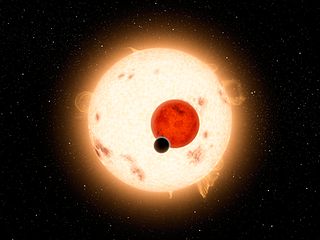
Kepler-16b is an exoplanet. It is a Saturn-mass planet consisting of half gas and half rock and ice, and it orbits a binary star, Kepler-16, with a period of 229 days. "[It] is the first confirmed, unambiguous example of a circumbinary planet – a planet orbiting not one, but two stars," said Josh Carter of the Center for Astrophysics | Harvard & Smithsonian, one of the discovery team.

Kepler-16 is an eclipsing binary star system in the constellation of Cygnus that was targeted by the Kepler spacecraft. Both stars are smaller than the Sun; the primary, Kepler-16A, is a K-type main-sequence star and the secondary, Kepler-16B, is an M-type red dwarf. They are separated by 0.22 AU, and complete an orbit around a common center of mass every 41 days. The system is host to one known extrasolar planet in circumbinary orbit: the Saturn-sized Kepler-16b.
Kepler-22 is a Sun-like star in the northern constellation of Cygnus, the swan, that is orbited by a planet found to be unequivocally within the star's habitable zone. It is located at the celestial coordinates: Right Ascension 19h 16m 52.2s, Declination +47° 53′ 3.9″. With an apparent visual magnitude of 11.7, this star is too faint to be seen with the naked eye. It can be viewed with a telescope having an aperture of at least 4 in (10 cm). The estimated distance to Kepler-22 is 644 light-years.
Kepler-20 is a star about 934 light-years from Earth in the constellation Lyra with a system of at least five, and possibly six, known planets. The apparent magnitude of this star is 12.51, so it cannot be seen with the unaided eye. Viewing it requires a telescope with an aperture of 15 cm (6 in) or more. It is slightly smaller than the Sun, with 94% of the Sun's radius and about 91% of the Sun's mass. The effective temperature of the photosphere is slightly cooler than that of the Sun at 5466 K, giving it the characteristic yellow hue of a stellar class G8 star. The abundance of elements other than hydrogen or helium, what astronomers term the metallicity, is approximately the same as in the Sun. It may be older than the Sun, although the margin of error here is relatively large.

Kepler-34 is an eclipsing binary star system in the constellation of Cygnus. Both stars have roughly the same mass as the Sun and, like the Sun, both are spectral class G. They are separated by 0.22 AU, and complete an eccentric (e=0.5) orbit around a common center of mass every 27 days.
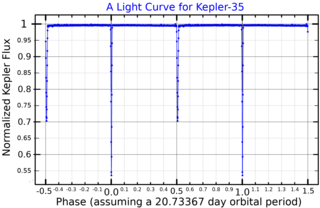
Kepler-35 is a binary star system in the constellation of Cygnus. These stars, called Kepler-35A and Kepler-35B have masses of 89% and 81% solar masses respectively, and both are assumed to be of spectral class G. They are separated by 0.176 AU, and complete an eccentric orbit around a common center of mass every 20.73 days.
Kepler-47 is a binary star system in the constellation Cygnus located about 3,420 light-years away from Earth. The stars have three exoplanets, all of which orbit both stars at the same time, making this a circumbinary system. The first two planets announced are designated Kepler-47b, and Kepler-47c, and the third, later discovery is Kepler-47d. Kepler-47 is the first circumbinary multi-planet system discovered by the Kepler mission. The outermost of the planets is a gas giant orbiting within the habitable zone of the stars. Because most stars are binary, the discovery that multi-planet systems can form in such a system has impacted previous theories of planetary formation.

Kepler-47c is an exoplanet orbiting the binary star system Kepler-47, the outermost of three such planets discovered by NASA's Kepler spacecraft. The system, also involving two other exoplanets, is located about 3,400 light-years away.

Kepler-62 is a K-type main sequence star cooler and smaller than the Sun, located roughly 980 light-years from Earth in the constellation Lyra. It resides within the field of vision of the Kepler spacecraft, the satellite that NASA's Kepler Mission used to detect planets that may be transiting their stars. On April 18, 2013, it was announced that the star has five planets, two of which, Kepler-62e and Kepler-62f are within the star's habitable zone. The outermost, Kepler-62f, is likely a rocky planet.
K2-3, also known as EPIC 201367065, is a red dwarf star with three known planets. It is on the borderline of being a late orange dwarf/K-type star, but because of its temperature, it is classified as a red dwarf.
HD 3167 is a single, orange-hued star in the zodiac constellation of Pisces that hosts a system with three exoplanets. The star is too faint to be seen with the naked eye, having an apparent visual magnitude of 8.97. The distance to HD 3167 can be determined from its annual parallax shift of 21.1363 mas as measured by the Gaia space observatory, yielding a range of 154 light years. It has a relatively high proper motion, traversing the celestial sphere at the rate of 0.204″ per year. Since it was first photographed during the Palomar observatory sky survey in 1953, it had moved over 12.5″ by 2017. The star is moving away from the Earth with an average heliocentric radial velocity of +19.5 km/s.
Planet-hosting stars are stars which host planets, therefore forming planetary systems.
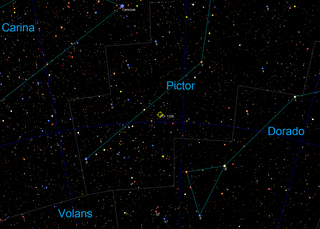
TOI-1338 is a binary star system located in the constellation Pictor, about 1,320 light-years from Earth. It is orbited by two known circumbinary planets, TOI-1338 b, discovered by the Transiting Exoplanet Survey Satellite (TESS) and BEBOP-1c, discovered by the Binaries Escorted By Orbiting Planets project.
Kepler-737 is an M-type main-sequence red dwarf located 671 light-years away on the border of the constellation Cygnus.
References
- 1 2 3 4 5 Vallenari, A.; et al. (Gaia collaboration) (2023). "Gaia Data Release 3. Summary of the content and survey properties". Astronomy and Astrophysics. 674: A1. arXiv: 2208.00211 . Bibcode:2023A&A...674A...1G. doi: 10.1051/0004-6361/202243940 . S2CID 244398875. Gaia DR3 record for this source at VizieR.
- 1 2 Orosz, Jerome A.; et al. (2012), "THE NEPTUNE-SIZED CIRCUMBINARY PLANET KEPLER-38b", The Astrophysical Journal, 758 (2): 87, arXiv: 1208.3712 , Bibcode:2012ApJ...758...87O, doi:10.1088/0004-637X/758/2/87, S2CID 119226095
- ↑ "Notes for star Kepler-38(AB)". Extrasolar Planets Encyclopaedia . 2012. Retrieved 29 April 2013.[ dead link ]
- ↑ "Kepler-38". SIMBAD . Centre de données astronomiques de Strasbourg . Retrieved 4 January 2017.
- ↑ Macau, E E N.; Domingos, R. C.; Izidoro, A.; Amarante, A.; Winter, O. C.; Barbosa, G. O. (2020), "Earth-size planet formation in the habitable zone of circumbinary stars", Monthly Notices of the Royal Astronomical Society, 494: 1045–1057, arXiv: 2003.11682 , doi:10.1093/mnras/staa757, S2CID 214667061